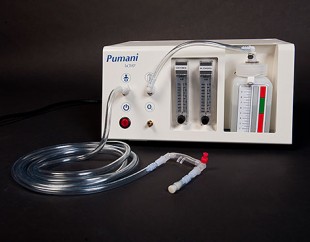Rice bioengineering student invention named one of 10 ‘Breakthrough Innovations’
Rice University’s student-created “bubble CPAP” system is featured in a new United Nations publication, “Breakthrough Innovations That Can Save Women and Children Now,” which highlights 10 medical devices, drugs, vaccines and practices that can help the U.N. achieve its ambitious goal of saving the lives of 16 million women and children by 2015. Bubble CPAP (bCPAP) is a low-cost respiratory support system for newborns.
Rice’s bCPAP technology was on display at the U.N. General Assembly when Secretary-General Ban Ki-moon unveiled the breakthrough innovations Sept. 23 as part of the Every Woman, Every Child program. This U.N. effort aims to mobilize governments, multilaterals, the private sector and civil society to address the major health challenges facing women and children around the world.

Rice University's Pumani breathing system, a "bubble CPAP" device created by students in Rice's Beyond Traditional Borders program, is featured in a new United Nations publication highlighting innovations that can save the lives of women and children.
“This publication outlines 10 innovations that will have an immediate impact on the leading killers of women and children,” Ban said. “From new medicines that prevent deadly infections in newborns to new uses of supply chains to deliver medicines to the most remote areas, these are game-changing practices and advances.”
Rice’s bCPAP technology — which has also been featured at the White House — uses low-cost aquarium pumps to generate “continuous positive airway pressure,” or CPAP. The system helps keep children’s lungs inflated, which makes it easier for them to breathe. It is particularly beneficial for premature newborns and is widely available in the developed world, but the machines there cost about $6,000 and are too expensive for most hospitals in the developing world.
The low-cost CPAP technology was created in 2010 by a student team that included Jocelyn Brown ’10, Michael Pandya ’10, Joseph Chang ’10, Haruka Maruyama ’10 and Katie Schnelle ’10. The students created the technology as part of Rice’s Beyond Traditional Borders (BTB) program, an award-winning, hands-on engineering education program of the Rice 360°: Institute for Global Health Technologies. Their technology was later named Pumani, which means “breathe easy” in Chichewa, one of the languages spoken in Malawi. A clinical trial in Malawi found that Pumani greatly improved the survival rates for premature babies and delivered the same therapeutic flow and pressure as systems used in the developed world.
“It’s very exciting to see Rice’s Pumani bCPAP technology featured at the U.N. and to have the opportunity to expand its ability to save lives across the world,” said Rebecca Richards-Kortum, Rice’s Stanley C. Moore Professor and chair of the Department of Bioengineering and director of both BTB and Rice 360°.
BTB co-director Maria Oden said BTB is already working with Malawi’s Ministry of Health to implement Pumani in all of that country’s hospitals, and she is hopeful that the U.N. recognition will allow Rice 360° to expand its rollout of bCPAP devices in other countries.


Leave a Reply